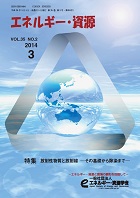All issues

Volume 35 (2014)
- Issue 6 Pages 1-
- Issue 5 Pages 1-
- Issue 4 Pages 1-
- Issue 3 Pages 1-
- Issue 2 Pages 1-
- Issue 1 Pages 1-
Volume 35, Issue 2
Displaying 1-4 of 4 articles from this issue
- |<
- <
- 1
- >
- >|
Research Paper
-
Tomoki Takahashi, Toru SatoArticle type: Research Paper
2014Volume 35Issue 2 Pages 1-10
Published: 2014
Released on J-STAGE: February 15, 2019
JOURNAL FREE ACCESSPublic acceptance is one of the most important issues when considering the sustainability of anthropogenic systems. In order to develop future energy systems, it is necessary to take into account the balance of environmental impact, economical feasibility, and public acceptance. Based on the existing indices for inclusive environmental impacts, such as the Inclusive Impact Index (Triple I) and the emergy, the present work proposes new indices: Triple I and Triple Iemergy which can evaluate public acceptance together with economical and environmental aspects simultaneously. Here, we applied these indices to several power generation technologies. To quantify the expectation and uneasiness of the public, we conducted a questionnaire survey about the selected eight power generation technologies. However, the survey respondents were under- and postgraduates only and this limits this survey to a preliminary study. The conjoint analysis reveals the marginal rate of allowance to compensate (MRAC), which we coined the calculated values instead of calling the marginal willingness to pay (MWTP), in each unit of currency, ecological footprint, or emergy for six attributes that are considered to affect public acceptance. Using the MRAC, Triple I and Triple Iemergy of the power generation technologies are calculated. Eventually, it is conjectured that, if the analysis of the questionnaire is accurate enough, the results can be used to evaluate the sustainability of the technologies.View full abstractDownload PDF (540K) -
Keita Azechi, Shutaro Hori, Shigeo Nishikizawa, Takehiko MurayamaArticle type: Research Paper
2014Volume 35Issue 2 Pages 11-22
Published: 2014
Released on J-STAGE: February 15, 2019
JOURNAL FREE ACCESSThis paper aimed to clarify factors influencing environmental conflict occurrence during the planning stage for wind farm projects in Japan. After studying conflict occurrence situations and the main conflict issues for 155 large-scale projects across Japan, we focused on both physical and social factors as explanatory variables and applied a quantitative method using binary logistic regression analysis. The main findings were: (1) environmental conflicts had occurred in 59 projects as of May 2012 and the main issues could be classified as noise/infrasound, sediment- related disaster/hydrology, landscape, nature destruction and birds (esp. raptors); (2) turbine number and size were influential factors as structural aspects, while there was no significant association between proximity to turbines and conflict occurrence; (3) sites located within natural parks, national protection forests, sediment-related disaster hazardous areas and wildlife protection areas designated by relevant acts and ordinances showed higher conflict occurrence, and proximity to such areas could be influential as well; (4) habitats for Golden Eagle, Mountain Hawk Eagle, White-tailed Eagle and Steller's Sea Eagle significantly encouraged conflict; (5) in terms of social aspects at both the national and prefectural level, conflict occurrence was strongly associated with the existence of past conflict experiences and complaints about noise and/or infrasound generated by operating wind farms.View full abstractDownload PDF (1093K) -
Yuhji Matsuo, Yasuaki Kawakami, Yoshiaki Shibata, Shigeru Suehiro, Aki ...Article type: Research Paper
2014Volume 35Issue 2 Pages 23-32
Published: 2014
Released on J-STAGE: February 15, 2019
JOURNAL FREE ACCESSIn this paper the authors estimated long-term hydrogen introduction scenarios in Japan up to 2050, using an integrated energy model which combines an econometric demand model and a bottom-up type technology introduction model, and assuming the introduction of “CO2-free” imported hydrogen. In the cases that assume ambitious CO2 emission reduction targets, and set realistic limits for Carbon Capture and Storage (CCS), a massive volume of hydrogen is introduced as a fuel for combined cycle power generation, reducing the marginal CO2 abatement costs significantly.
In normal cases the use of CO2-free hydrogen is less cost-effective than the introduction of CCS. It must be noted, however, that CO2-free hydrogen can gain cost-effectiveness if imported fossil fuel prices become extremely high. In this perspective, the option of introducing CO2-free hydrogen can be regarded as a measure to reduce the risk of price spikes and/or an alternative measure to reduce CO2 emissions with the possible limited availability of the CCS technology.View full abstractDownload PDF (704K) -
Seiji Yamashita, Yasushi Yoshino, Kenji Yoshimura, Kenjiro Shindo, Eii ...Article type: Research Paper
2014Volume 35Issue 2 Pages 33-38
Published: 2014
Released on J-STAGE: February 15, 2019
JOURNAL FREE ACCESSA concept of hydrogen energy supply chain is proposed and its feasibility is examined. The hydrogen is derived from abundant brown coal in Australia. Co-produced CO2 is stored in the CarbonNet, promoted by Australian government. The hydrogen is then liquefied, transported and utilized as carbon free energy in Japan. In the present study, conceptual design for the whole supply chain is conducted to evaluate CAPEX and OPEX. The result shows that the hydrogen CIF cost is 29.7¥/Nm3 (22US$/MMBTU), revealing the feasibility of CO2 free hydrogen supply chain in economically and technically.View full abstractDownload PDF (1593K)
- |<
- <
- 1
- >
- >|